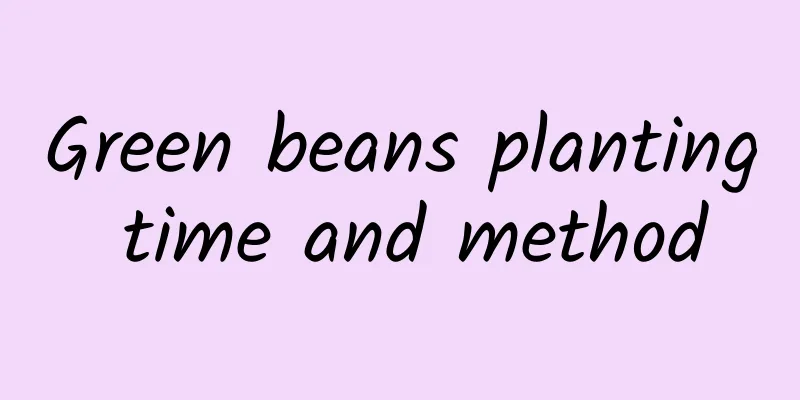When is the right time to transplant onions?

|
Onion is an ancient plant native to Southwest Asia with a long history and wide range of uses. It was introduced into my country during the Western Han Dynasty and spread to the world after the Age of Discovery. Onions are rich in nutrients, good for health, and widely grown. So when is the best time to transplant onions? Let’s take a look below. 1. When is the best time to transplant onions? The best time to transplant onions usually depends on several factors, including climate, soil conditions, and the onion's growth stage. Generally speaking, it is best to transplant onions when the weather is cool and the soil is moist, so as to ensure that the onion seedlings can take root and grow smoothly. Specifically, when the onion seedlings grow to a certain height (for example, about 10-15 cm) and the weather gradually turns cooler, it is a more appropriate time to transplant them. In addition, make sure the soil after transplanting is fertile and well-drained so that it can provide sufficient nutrients and water for the growth of onions. 2. How to transplant onions? 1. Land preparation and fertilization before transplanting After the previous crop is crushed, the land should be deeply plowed to a depth of 20 cm. When plowing the land, use low gear and high speed. The finer the better. Then apply compound fertilizer as base fertilizer, or use high-potassium potassium sulfate compound fertilizer and spread it evenly on the ground surface. 2. Dip the roots in medicine When transplanting onions, dip the roots in chemicals to prevent diseases, control insects, promote root growth, and promote early growth. Specific method: Soak the roots of the seedling bundle in the medicine solution for a while, then pour off the excess liquid and put it into a plastic box. The liquid medicine formula can be selected from 70% Aimeile (imidacloprid) water dispersible granules 12 grams (4 bags) + 0.01% 28 Gaorongcai 20 ml + 30% Rui Miaoqing (metalxam·carbendazim) aqueous solution 20 ml, to 15 kg of water. 3. Transplantation The transplanting standard is plant and row spacing of 15×16 cm or 16×16 cm. Transplant 8 rows per plot; transplanting depth is 2-3 cm, slightly deeper in sandy soil and slightly shallower in clay soil, just enough to bury the small bulbs; plant about 25,000 plants per mu, varieties with short growing periods are suitable for dense planting, while varieties with long growing periods are suitable for sparse planting; sparse planting is suitable in areas with good water and fertilizer conditions and fertile soil, otherwise dense planting is suitable; when transplanting, the seedlings should be vertical up and down, and not tilted to the left and right. 4. Management after transplanting (1) Check and replant seedlings 3-4 days after transplanting. (2) Depending on the weather and soil moisture conditions, water the plants 3-5 days after transplanting to promote survival. (3) Water the soil shallowly once every 3 days after transplanting the seedlings, and then water it twice every 25 days. After that, water every 10-15 days depending on the temperature. In addition, apply about 65 kg of urea during the entire growth period, combined with the 2nd to 7th watering. 5. Pest and disease control The period from the time when onions are transplanted and the time when the first seedling-promoting water is watered is the time when onion virus diseases are most likely to occur. Thrips, leaf miners and root rot also begin to occur sporadically. We must take into account the characteristics of the disease and do a good job of preventing and treating it with the right medicine. In general, doing a good job of onion transplanting is an effective measure to increase yield. In addition, I would like to remind everyone that when transplanting onion seedlings in spring, the use of mulch can significantly increase onion yield and improve quality. Those who have not used mulch can give it a try.
|
<<: When will spinach be harvested if planted in October?
>>: Egg duck breeding technology and methods
Recommend
Is it better to use diammonium fertilizer or compound fertilizer to grow corn (what compound fertilizer is better to grow corn)
Is it better to use diammonium phosphate or compo...
How to grow pineapple flowers
1. Breeding environment 1. Soil: To grow pineappl...
How to propagate Thousand Birds Flower
Seed propagation of Thousand Birds Flower The sea...
How to cultivate Isuzu jade in color
Plant characteristics First, understand its prefe...
Advantages and disadvantages of Vesalius rose: Is it a climbing rose or a shrub rose?
Vesalius is a shrub rose , a variety cultivated a...
Cyclamen seed germination method
The germination of cyclamen is related to seasona...
Geranium rejuvenation method
Geranium rejuvenation method In fact, to rejuvena...
What flowers are suitable for growing in Chengdu? What are the city flowers and trees?
1. Chengdu’s Climate Characteristics Chengdu has ...
How much is a pound of wild golden thread lotus, how much is a pound of golden thread lotus seeds
1. Wild price Relatively speaking, wild golden th...
How to make water lily sprout quickly
Water lily germination environment Water lilies p...
Which month is best to transplant peonies?
Peony is a precious woody flower unique to China....
The difference between the Kapok tree and the Beauty Tree
1. Difference in appearance The kapok tree can gr...
Is coffee a tropical crop? Is it a tropical cash crop?
Is coffee a tropical crop? Coffee is a tropical c...
How to propagate Rosa candidum
Propagation method 1: sowing When we propagate pl...
How to save yam seeds
Yam Seed Introduction Yams have seeds, which usua...









